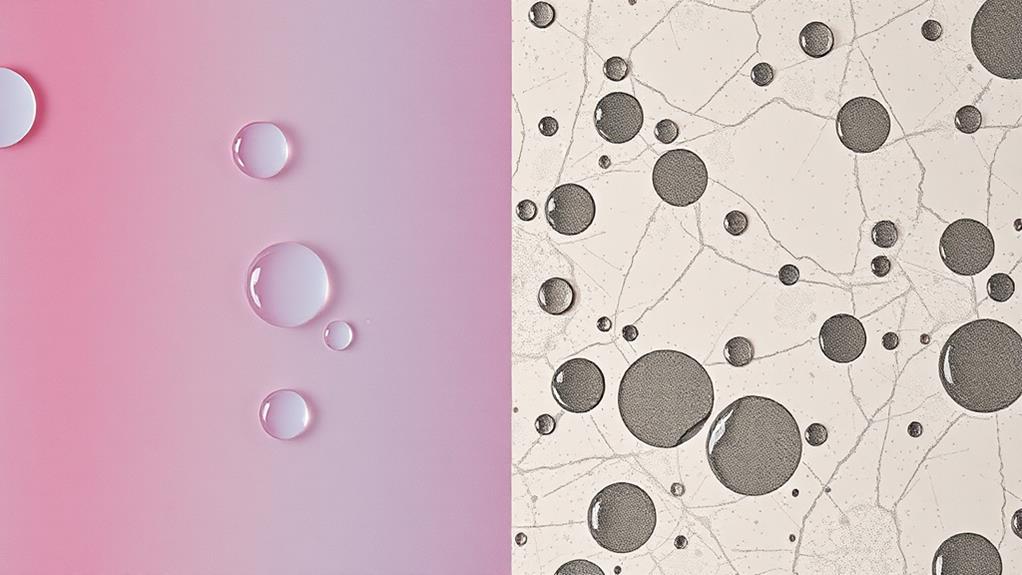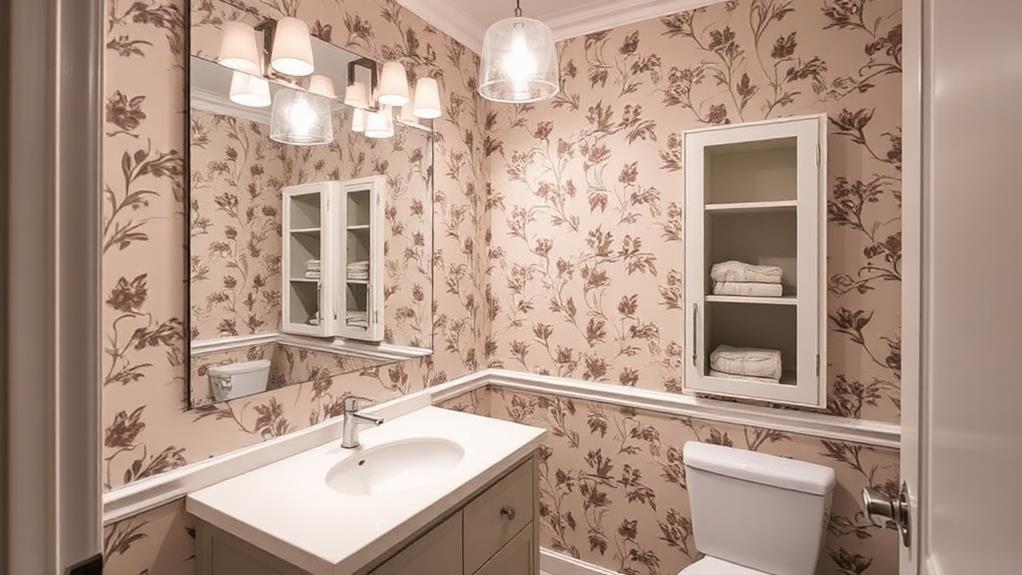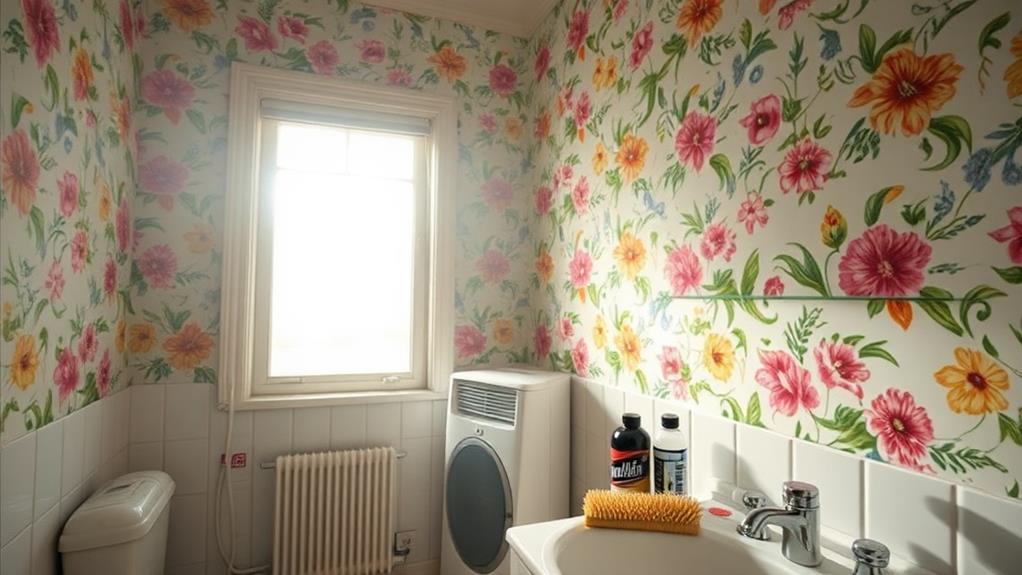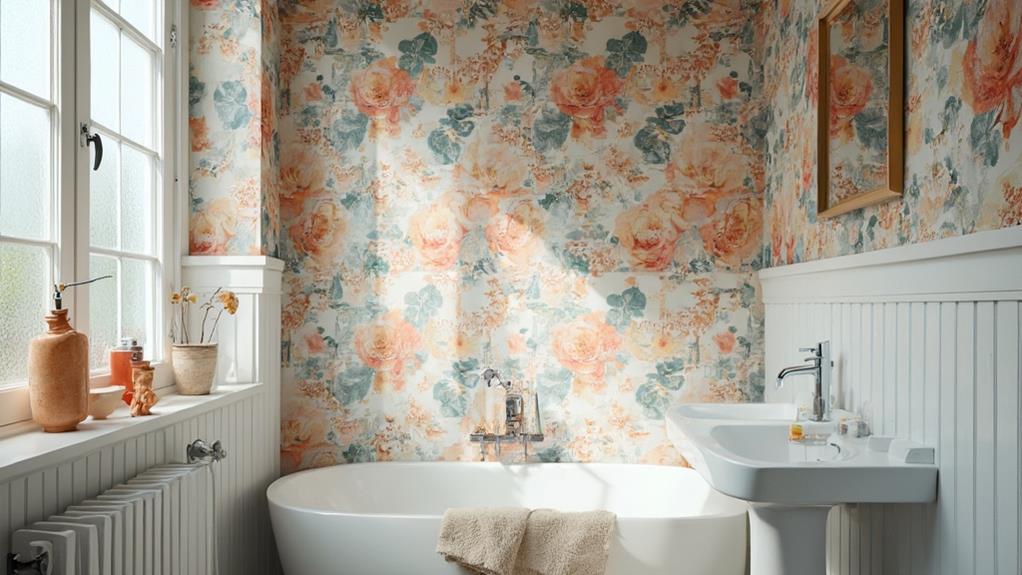When reviving bathroom wallpaper, choose moisture-resistant materials like vinyl or non-woven options. Properly prepare walls by cleaning, repairing, and priming before installation. In small bathrooms, opt for light colors and small-scale patterns to create an illusion of space. Complement existing fixtures and accessories by considering color, style, and scale. Maintain your wallpaper by applying sealant, cleaning regularly, and ensuring proper ventilation. Don't forget to address any damage promptly and avoid hanging wet items directly on the wallpaper. By following these dos and don'ts, you'll create a stunning, long-lasting bathroom design that brings classic elegance back into your home. Discover more tips to perfect your bathroom wallpaper revival.
Choosing Moisture-Resistant Wallpaper Materials

When selecting wallpaper for your bathroom, moisture resistance is key. You'll want to choose materials specifically designed to withstand high humidity and occasional splashes. Vinyl wallpaper is a popular choice due to its durability and water-resistant properties. Look for options labeled as "washable" or "scrubbable" for easy maintenance.
Another excellent option is non-woven wallpaper. It's breathable, preventing moisture from getting trapped behind it, and it's also easy to clean. Some manufacturers offer specially treated papers with antimicrobial properties, which can help prevent mold and mildew growth in damp environments.
If you're set on using traditional paper wallpaper, consider applying a clear, water-resistant sealant over it to provide an extra layer of protection. However, keep in mind that this may alter the paper's appearance slightly.
For areas directly exposed to water, such as around the sink or bathtub, you might want to use tile or a waterproof wall panel instead. You can then complement these with wallpaper in drier areas of the bathroom to create a cohesive look while ensuring longevity and practicality.
Proper Preparation and Installation Techniques
Preparing your bathroom walls properly is crucial for successful wallpaper installation. Begin by cleaning the walls thoroughly with a mild detergent and water solution, removing any dirt, dust, or grime.
Next, repair any cracks, holes, or imperfections using spackle or joint compound, and sand the surface smooth once dry.
Apply a high-quality, mold-resistant primer to create a uniform surface and enhance wallpaper adhesion. Allow the primer to dry completely before proceeding.
Measure your walls accurately and cut your wallpaper panels accordingly, leaving a few extra inches for trimming.
When installing, start in an inconspicuous corner and work your way around the room. Use a level to ensure straight application, and smooth out air bubbles with a plastic smoothing tool. Pay special attention to seams, pressing them firmly to create a seamless look.
For areas around fixtures, windows, and doors, use a sharp utility knife to trim excess paper carefully. Don't forget to apply a thin bead of clear silicone caulk along the edges where the wallpaper meets the tub, sink, or shower to prevent moisture from seeping behind the paper.
Design Strategies for Small Bathrooms

Designing for small bathrooms requires clever strategies to maximize space and create an illusion of openness. When choosing wallpaper for a compact bathroom, opt for light colors and small-scale patterns to make the room feel larger. Vertical stripes can elongate walls, while horizontal stripes can widen the space visually. Consider using a single accent wall with bold wallpaper to create a focal point without overwhelming the room.
To further enhance the sense of space, incorporate reflective surfaces like mirrors or metallic wallpaper accents. These elements bounce light around the room, making it appear brighter and more spacious. Don't forget to coordinate your wallpaper choice with other bathroom fixtures and accessories to maintain a cohesive look.
In small bathrooms, it's crucial to keep the overall design simple. Avoid cluttering the space with too many patterns or colors. Instead, choose a wallpaper that complements your existing tiles, flooring, and fixtures. You can also use wallpaper to define specific areas, such as the vanity or toilet area, while leaving other walls neutral. This approach adds interest without making the space feel cramped or busy.
Complementing Fixtures and Accessories
Harmony is key when selecting wallpaper to complement your bathroom fixtures and accessories. Consider the color, style, and finish of your existing elements, such as faucets, towel bars, and lighting fixtures. Choose wallpaper patterns that enhance these features rather than clash with them. For instance, if you have sleek, modern chrome fixtures, opt for geometric or minimalist wallpaper designs.
Don't forget to factor in your bathroom's overall color scheme. If you have neutral-toned tiles or countertops, you can be bolder with your wallpaper choice. Conversely, if your fixtures are already colorful or patterned, select a more subdued wallpaper to maintain balance.
Consider the scale of your wallpaper pattern in relation to your bathroom's size and the dimensions of your fixtures. Large-scale patterns can overwhelm small spaces, while tiny prints might get lost in larger bathrooms. Aim for a complementary balance between your wallpaper and accessories.
Remember that your wallpaper should enhance, not overpower, your fixtures. Use it as a backdrop to showcase statement pieces like a vintage mirror or an artistic light fixture. By carefully coordinating your wallpaper with your bathroom's fixtures and accessories, you'll create a cohesive and stylish space.
Maintenance and Longevity Tips

To ensure your bathroom wallpaper stands the test of time, proper maintenance is crucial. Start by applying a high-quality sealant to protect the paper from moisture and steam. Clean your wallpaper regularly with a soft, dry cloth to remove dust and prevent buildup. For tougher stains, use a slightly damp cloth with mild soap, but avoid excessive water.
Invest in a good ventilation system to reduce humidity and prevent mold growth. After showers or baths, open windows or run the exhaust fan to quickly remove moisture from the air. Consider using a dehumidifier in particularly damp bathrooms.
Inspect your wallpaper periodically for signs of peeling or damage. Address any issues promptly to prevent further deterioration. If you notice loose edges, carefully reattach them using wallpaper adhesive.
Avoid hanging wet towels or clothing directly on the wallpaper, as this can lead to water damage and discoloration. Instead, install towel racks or hooks away from wallpapered areas.
Conclusion
Bathroom wallpaper can transform your space from sterile to stunning, from bland to bold. You'll breathe new life into a once-forgotten design element, but remember: moisture is your enemy, preparation is your ally. While vibrant patterns can energize small spaces, don't let them overwhelm. Choose wisely, install carefully, and maintain diligently. Soon, you'll be basking in a bathroom that's both stylish and functional, where classic charm meets modern practicality. Embrace the revival, but respect the rules.

